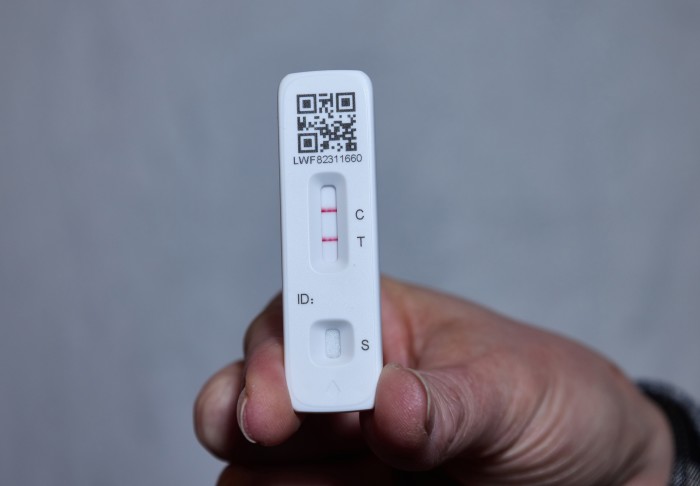Lateral flow tests may be missing ‘substantial’ number of COVID-19 infections

Lateral flow tests appear to miss a substantial number of COVID-19 infections, particularly for people without symptoms, experts have warned.
Analysis by a team including experts from Imperial College London found that the proportion of people with current COVID-19 infection missed by the Innova brand of lateral flow test (LFT) was “substantial enough to be of clinical importance”.
The study, which was a collaboration between Imperial College London and the University of Birmingham, looked at the effectiveness of the devices in three settings – symptomatic testing at an NHS Test-and-Trace centre, mass testing in Liverpool in residents without symptoms, and asymptomatic screen testing in students at the University of Birmingham.
It found that the devices would miss between 20 per cent and 81 per cent of positive cases in the different settings – 20 per cent at the Test and Trace centre, 29 per cent in the city-wide mass testing, and 81 per cent in the university screen testing.
Professor Ajit Lalvani, from Imperial’s National Heart & Lung Institute, and Dr Anika Singanayagam, from Imperial’s Department of Infectious Disease, both worked on the analysis, which has been published in The BMJ.
"A negative LFT should be used in conjunction with other measures (such as good ventilation, face masks) in [high-risk] settings to reduce overall risk." Dr Anika Singanayagam Clinical Lecturer, Department of Infectious Disease
The authors warn that claims LFTs can identify the “vast majority” of infectious cases are likely to be overstated and risk providing false reassurance to the public – although they note that the tests are still an important tool for controlling the pandemic.
Dr Singanayagam said: “Lateral flow tests will miss a proportion of people who are infectious, particularly during the early stages of infection.
“This means that using them as a ‘green light’ test, for example to go and visit a vulnerable person, could be providing false reassurance.
“A negative LFT should be used in conjunction with other measures (such as good ventilation, face masks) in such settings to reduce overall risk.”
The researchers used real-world data to predict the proportion of Innova LFTs that produce negative results in those with a high risk of SARS-CoV-2 infectiousness and then compared this data with predictions made by mathematical models.
Their aim was to identify the joint probability for a person who is likely to be infectious (either because they have a viral culture positive result or are a secondary case) and yet had tested negative on an LFT.
The results came from studying NHS Test and Trace data from September 2020 to February 2021, mass testing data from Liverpool in November 2020 and testing data from Birmingham in December 2020.
Researchers looked at 2,474,066 eligible contacts from NHS Test and Trace, 5,869 residents in Liverpool who were tested as part of the city’s mass testing programme, and more than 7,000 university students tested with LFTs in Birmingham.
Public health risk from missed infections
The authors noted that evaluating the accuracy of a test for current infection or infectiousness is challenging due to the lack of a reference standard, adding that the findings in their analysis “must be taken as illustrative and not exact”.
However, they wrote: “Allowing for the uncertainties in the results from our analyses, the proportion of people with current infection missed by the Innova LFT is likely to be of public health importance, particularly in settings with greater proportions of infectious people with lower viral loads; where the tests are often being applied.”
"We need good quality studies that follow people regularly over time to understand how infectiousness changes while you have COVID-19." Dr Anika Singanayagam Clinical Lecturer, Department of Infectious Disease
The authors also argue that mathematical models have failed to appropriately use empirical evidence to inform assumptions about the accuracy of LFTs and the possibility of infectiousness, resulting in unrealistic overestimates of test accuracy.
Dr Singanayagam added that it was important for people to understand the limitations of such tests and for evaluations of their performance to be based on real-world data.
She added: “We need good quality studies that follow people regularly over time, to understand how infectiousness changes while you have COVID-19, and how accurately lateral flow tests can detect when people are infectious.
“Analysis of real-world data should feed into cost-effectiveness analyses that help to direct where future testing is applied.”
-
‘SARS-CoV-2 antigen lateral flow tests for detecting infectious people: linked data analysis’ by Jonathan J Deeks et al is published in The BMJ.
Main image credit: Shutterstock.
Article supporters
Article text (excluding photos or graphics) © Imperial College London.
Photos and graphics subject to third party copyright used with permission or © Imperial College London.
Reporter
Conrad Duncan
Communications Division